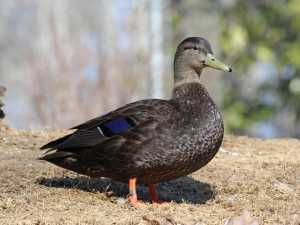 Black
Duck Black
DuckAnas rubripes
Description
Breeding males have a buffy
head that is heavily streaked with black,
especially through the eye and on the tip of the
head. The upperparts are blackish brown. The
underparts feathers are dark sooty brown with
pale reddish and buff margins; the secondaries
are iridescent bluish purple; the tertials are
glossy black next to the speculum, gray to
blackish brown otherwise.
Both males and females have a
greenish yellow to bright yellow bill, with small
black spotting. The feet and legs of the male are
orange red, while those of the female are dusky
to olive-colored.
In flight, the black duck
appears to be nearly black, with an underwing
coloration that is in contrast with the rest of
its plumage.
Distribution and
Habitat
Black ducks breed from Manitoba
southeast to Minnesota, east through the Great
Lakes region to Maryland, West Virginia, and
Virginia, and in the forested portions of eastern
Canada to northern Quebec and northern Labrador.
They winter in the southern parts of their
breeding range, and south to the Gulf Coast of
Florida and Bermuda.
During the breeding season
black ducks live in a variety of fresh and
brackish waters in forest environments, including
alkaline marshes, acid bogs, muskegs, lakes,
ponds, stream margins, and tidewater bays and
estuaries. The rest of the year they live on
large, open lagoons and on the coast.
Reproduction
Breeding pairs begin to form
around the end of September, and breeding starts
in March and April.
Older females usually return to
their nesting areas of previous years, and may
even use an old nest site if still available. The
nest consists of a scrape on the ground,
concealed among vegetation, sometimes in tree
cavities or crotches, and lined with plant matter
and down.
Nine to ten eggs are laid,
usually one per day, and are incubated by the
female alone for about 27 days. Young are able to
leave the nest a few hours after hatching, but
remain with their mother until their sixth or
seventh week.
Diet
Black ducks eat the seeds and
vegetative parts of aquatic and crop plants, as
well as a relatively high proportion of
invertebrates. They feed primarily by grazing,
probing, dabbling or upending in shallow water,
although they will occasionally dive.
Habits and Behaviors
Black ducks are highly
gregarious outside of the breeding season,
occuring in flocks numbering in the thousands of
birds. Flock sizes gradually diminish, however,
as breeding pairs break away from the unpaired
individuals.
Scientific
Classification
phylum Chordata
subphylum Vertebrata
class Aves
order Anseriformes
family Anatidae
subfamily Anatinae
genus & species Anas rubripes

Animal Diversity Web http://animaldiversity.org/accounts/Anas_rubripes/
Questions or comments about
this page?
|



